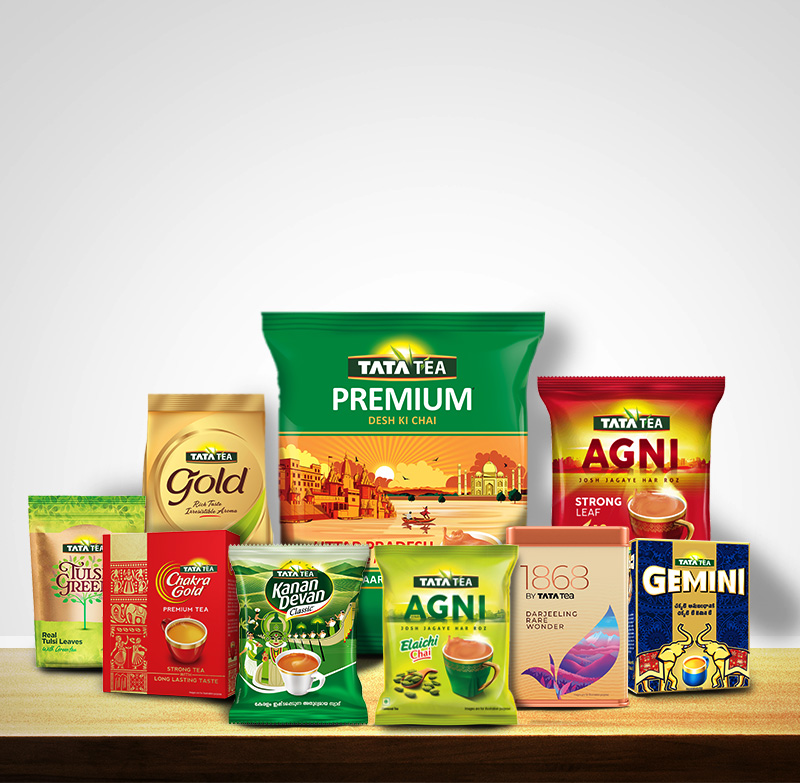Best tea brands for distributorship business in india-

Here are some of the best tea brands in India that are well-suited for a distributorship
business:
Tata Tea: One of the most trusted tea brands in India, Tata Tea offers a wide range of blends and flavors, including Tata Tea Premium, Tata Tea Gold, and Tata Tea Agni. Their established market presence makes it a reliable choice for distribution.
Brooke Bond Red Label: A popular brand from Hindustan Unilever, Brooke Bond Red Label is known for its strong flavors and wide consumer base. Its brand value can make it easier to penetrate the market.
Wagh Bakri: This is another leading tea brand in India with a loyal customer base. Wagh Bakri is known for its premium quality and diverse range, including strong and aromatic blends. It’s a great option for distribution.
Lipton: Known globally, Lipton’s green and black teas have a prominent presence in the Indian market. With health-conscious consumers turning towards green tea, this brand offers good growth potential.
Organic India: If you want to focus on health-conscious consumers, Organic India offers organic teas that are in high demand due to their natural ingredients and health benefits. Their Tulsi Green Tea is particularly popular.
Tetley: Another internationally known brand, Tetley has a strong presence in India. They offer both traditional and green teas, making them a versatile brand for distributors.
Society Tea: Based out of Mumbai, Society Tea has a strong market in Western India. They are well-reg arded for their aromatic and flavorful tea blends.
arded for their aromatic and flavorful tea blends.
Maharani Tea : Known for its premium quality tea, Duncans is a great option for distributorship in areas where high-quality tea is preferred.
Girnar Tea: Girnar specializes in instant tea premixes, masala chai, and green teas. With its growing popularity, it can be a good niche for distributors.
Goodricke Tea: Known for its Darjeeling and Assam tea, Goodricke offers premium teas and has a significant market share in northern and eastern India.
Tips for Choosing a Tea Brand for Distributorship:
Market Demand: Choose a brand that has strong demand in your target area.
Product Range: A brand with diverse offerings will allow you to cater to a broader audience.
Brand Reputation: A well-established and trusted brand will have better sales potential.
Profit Margins: Assess the profit margins and incentives offered by the company for distributors.
Why Tea distributorship business is profitable :
1. High Tea Consumption in India:
Cultural Significance: Tea is deeply embedded in Indian culture. It’s a staple beverage consumed in almost every household, from cities to rural areas. This high and consistent demand ensures a steady customer base.
Daily Habit: For many Indians, tea is a daily habit. With billions of cups consumed every year, the volume of consumption creates a huge market for tea distribution.
2. Large and Growing Market:
Expanding Population: India’s population is growing, and so is the middle class, which contributes to the rise in tea consumption. As disposable income increases, more people opt for premium and specialty teas, creating additional market opportunities.
Health Consciousness: With growing health awareness, people are shifting toward green tea, herbal teas, and organic teas, opening new segments for distribution.
3. Diverse Product Range:
The tea industry offers a variety of options, from low-cost mass-market teas to premium and specialty blends. This allows a distributor to cater to different income groups and preferences, enhancing profitability by targeting multiple market segments.
4. Year-Round Demand:
Unlike some other products that have seasonal sales, tea is in demand all year round. This constant demand ensures consistent sales, cash flow, and revenue throughout the year, making it a reliable business option.
5. Low Operational Costs:
Compared to other businesses, a tea distributorship has relatively low operational costs. Once you secure your supply chain and logistics, the expenses mainly involve storage, transportation, and maintaining relationships with retailers, making it a cost-effective business to manage.
6. Strong Brand Support:
Many tea brands in India provide strong marketing and promotional support to their distributors. Brands like Tata Tea, Lipton, and Wagh Bakri invest in advertisements, making it easier for distributors to sell products without spending much on marketing themselves.
7. Wide Distribution Network:
India has a well-established network for tea distribution. From kirana (grocery) stores to supermarkets, tea is sold in almost every retail outlet. As a distributor, tapping into these well-developed networks allows you to reach consumers easily, which boosts sales and profits.
8. Profit Margins:
Tea has a high margin of profit due to its relatively low production cost and high consumption rates. Distributors often earn good commissions from manufacturers and can negotiate for bonuses, incentives, and discounts based on bulk purchases or reaching sales targets.
9. Scalability:
The tea distribution business can easily scale up. You can start small and gradually expand your operations by adding more regions, outlets, and different tea brands. As your network grows, so do your profit margins.
10. Export Opportunities:
India is one of the world’s largest tea producers, and with the growing demand for Indian tea globally, distributors can tap into export opportunities. Selling high-quality tea to international markets adds another revenue stream to the business.
11. Franchise and Partnership Models:
Many leading tea brands offer distributorship or franchise models, where they provide structured business support, including training, marketing, and sales strategies. This reduces the risk and helps distributors grow faster, resulting in higher profits.
How to start distributors of Top tea Brands :
Starting a distributorship for top tea brands in India involves several steps, from understanding market dynamics to forming partnerships with leading tea companies. Here’s a step-by-step guide to help you get started:
1. Research the Tea Market:
Understand Demand: Study the tea consumption trends in your target area, including which types of tea (black tea, green tea, masala chai, etc.) are popular. This will help you determine which brands and products have the highest potential.
Competitor Analysis: Analyze the existing distributors in your region. Understand what brands they carry and how you can differentiate your offerings (e.g., through better customer service, a wider variety, or niche products like organic tea).
2. Choose the Right Tea Brand(s)
Identify Potential Brands: Focus on well-established tea brands like Tata Tea, Brooke Bond, Wagh Bakri, Lipton, Society Tea, Organic India, etc. Research each brand’s market reputation, product range, and distribution policies.
Evaluate Brand Requirements: Most brands will have certain criteria for appointing distributors. Some may require an initial investment, while others may look for a certain type of business infrastructure. Evaluate these requirements to see which brands align with your resources and goals.
3. Prepare a Business Plan
Set Financial Goals: Outline how much capital you’ll need for the initial investment, inventory purchase, warehousing, transportation, and marketing. Ensure your plan includes projections for profitability and growth.
Define Your Distribution Network: Identify your target areas and the type of retailers you will supply (e.g., grocery stores, supermarkets, cafes). Plan your network geographically and segment it based on demand.
Create a Marketing Strategy: Though big tea brands will support marketing to some extent, plan how you’ll attract retailers to work with you and how you’ll promote your services (e.g., offering competitive prices, fast deliveries, etc.).
4. Contact the Tea Companies
Reach Out to Brands: Visit the official websites of the top tea brands or contact their regional offices to inquire about distributorship opportunities. Many brands have online forms or dedicated teams to handle distributorship requests.
Submit an Application: You’ll typically need to fill out a form detailing your business, financial capacity, distribution network, and your experience (if any) in FMCG distribution. Prepare all necessary documents such as your business license, GST registration, and bank account details.
Negotiate Terms: Once a brand shows interest, discuss the terms of the partnership. This includes the margin they offer, sales targets, promotional support, and payment terms. Be sure to clarify your exclusivity rights, if any, within a region.
5. Register Your Business
Company Registration: Register your business with the relevant authorities. You can set up a sole proprietorship, partnership firm, or private limited company, depending on your scale of operations.
GST Registration: Since you’ll be involved in sales and distribution, GST registration is mandatory. This will allow you to sell legally and avail tax credits.
Licenses and Permits: Ensure you have all necessary licenses, such as a trade license from the local municipal authority and an FSSAI license (since tea is a food product).
6. Set Up Infrastructure
Warehouse: Secure a warehouse to store your tea stock. The size of your warehouse will depend on the scale of your distribution. Ensure the space is well-ventilated and secure, as tea can be sensitive to humidity and temperature changes.
Transportation: You’ll need a fleet (or contracts with transporters) to distribute tea to retail outlets. Efficient logistics ensure timely deliveries and help you build a good reputation with retailers.
Staff: Hire the necessary staff, including warehouse managers, delivery personnel, and sales representatives to manage daily operations and build relationships with retailers.
7. Build Your Retail Network
Identify Retailers: Build a list of potential retailers (e.g., grocery stores, supermarkets, cafes, online platforms) in your area. Visit them in person to pitch the tea brand and discuss how you can supply their tea stock.
Offer Attractive Deals: Initially, offer competitive prices, flexible payment terms, or discounts to attract retailers. Leverage brand promotions and marketing campaigns run by the tea company to help sell the product.
Create Long-Term Relationships: Regular follow-ups, reliable deliveries, and consistent service help you build trust and loyalty among your retailers.
8. Promote Your Distributorship
Leverage Brand Promotions: Established tea brands often run nationwide marketing campaigns, but you can further promote their products locally. Use banners, point-of-sale displays, and digital marketing (social media, WhatsApp groups) to promote the availability of top tea brands through your distributorship.
Participate in Local Events: Partner with brands to sponsor or participate in local events, exhibitions, and food fairs where you can introduce and distribute samples of the tea products.
9. Manage Finances Efficiently
Inventory Management: Keep track of your inventory to avoid stockouts or overstocking. Use software tools to manage and forecast demand, ensuring a smooth flow of goods.
Cash Flow Management: Since distributors often buy products in bulk, cash flow management is crucial. Plan your payments and collections cycle so you can reinvest profits into expanding your operations.
10. Monitor Performance & Expand
Sales Tracking: Regularly monitor your sales performance to ensure you are meeting targets. Evaluate which tea products sell the most and adjust your strategy accordingly.
Expand Your Network: Once your business is running smoothly, consider expanding your distributorship to new areas or working with additional brands to diversify your portfolio.














